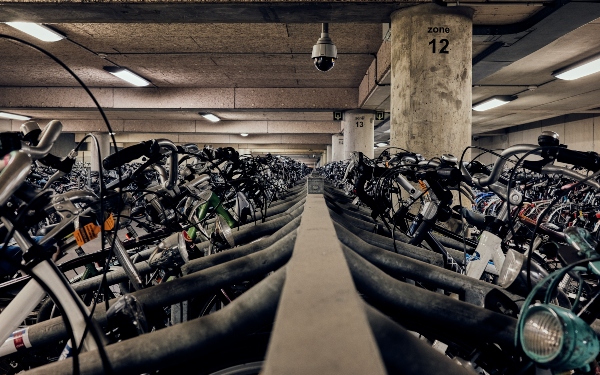
EPBD update: A recap of ECF’s lobbying efforts for better bike-parking provision throughout the EU
ECF provides an end-of-year update on our lobbying efforts to ensure bicycle parking is effectively included in the revision of the Energy Performance of Buildings Directive.
How can we use less materials in building construction? How can on-site parking encourage less CO2 transport emissions? How can we stimulate less household energy use? How can building construction promote sustainable transport?
The answer to these questions is to increase bicycle-parking facilities in European buildings.
As I’m sure all Eurocrat buffs know by now, there has been a revision of the EU’s Energy Performance of Buildings Directive (EPBD) underway in Brussels since 2021, and ECF has been working hard in our lobbying efforts to ensure requirements for bicycle parking in all residential and non-residential buildings are included.
On 15 December 2021, the Commission obliged by publishing a decent revision proposal that called for two bike-parking spaces for every new residential unit, and one bike-parking space for every car-parking space in all non-residential buildings with over 20 car-parking spaces (and over five car parking spaces for all new/renovated non-residential buildings).
Also included, however, was an “opt-out” clause which allows Member States to adjust non-residential requirements “where bicycles are typically less used as a means of transport”, and to just “ensure as many bicycle parking spaces as appropriate” in renovated residential buildings where “two bicycle parking spaces for every dwelling is not feasible”.
We believe this opt-out clause is too lenient and allows for Member States to ignore bike-parking requirements.
Since the publication of the Commission’s proposed revision, we have seen positive input from both the European Parliament, who published their draft report on the revision on 6 June, and the Council of the EU, who finalised their General Approach 21 October. Impressively, we can see evidence of ECF’s lobbying efforts throughout each!
So, what has the European Parliament proposed?
We lobbied the European Parliament to improve the Commission’s revision proposal which strarted off with an excellent draft report from the Industry, Research, and Energy committee (ITRE) mainly by trying to make the opt-out clauses more difficult for Member States’ public authorities to trigger and by providing other suggestions for the actual requirements on biking provision. However this has been of course watered down by successive amendments, and in fact became such a a contentious issue in the Parliament’s Transport Committee (TRAN) committee, that they were unable to decide on an outcome.
The Parliament still has to make its final decision for the report, but we think we could see a good progressive text from the ITRE Parliament committee. This is still a work in progress, but we believe that we will have a decent outcome here due to some excellent collaboration with the lead rapporteur from the Irish Greens MEP Ciarán Cuffe, as well as some good compromises from other rapporteur MEPs.

Credits: Alexander Van Steenberge via Unsplash.com
…and the Council of the EU?
For the Council’s finalised General Approach, ECF was asked by some Member States to provide text suggestions that can update the Commission’s proposal with no reference to car parking at all. To do so, we provided suggestions which relied on area and building use instead.
The Council’s General Approach was published in October 2022, with text stating that for all new and renovated residential buildings that have more than three car-parking spaces, there should be “at least two bicycle parking spaces for every residential building unit”. However, there is still an opt-out for renovated buildings, which states that Member States only have to ensure “as many spaces as appropriate” when it is deemed that the provision of two bicycle-parking spaces is not feasible during the renovation process. But given that the average household size is 2.3 in the EU, two parking spots per housing unit would mean that in principle almost every person moving into a new residential building would enjoy access to a bicycle-parking space if this becomes the final text.
For every new/renovated non-residential building with over five car-parking spaces, Member States want “bicycle parking spaces represent(ing) at least 15 % of the average user capacity of the building”, and the same for all other non-residential building over 20 parking spaces by January 2027. Again, there is a caveat, Member States would be allowed to adjust requirements for specific types of non-residential buildings “that are typically not accessed by bicycles”.
At ECF, we believe that this Council text will be the worst case scenario, and we hope for better from the Parliament.
What’s next for the EPBD revision?
When the final decision is made by the Parliament, the Parliament and Council will negotiate their two texts to hammer out a compromise text. We suspect that the Parliament will be more progressive than the Council, with higher requirements and a stricter opt-outs.
This is all great news, whatever the outcome. Even the worst case scenario (which would likely resemble the Council’s current General Approach, as outlined above) means that there will certainly be more provision of bike parking across all of EU’s buildings. This will mean greater access in our offices, schools and new/renovated houses.
We will be following developments in the Parliament and lobbying Member States to be more progressive – which has been made easier by the fact that six Member States (Belgium, Netherlands, France, Germany, Ireland, and Luxembourg have already publicly declared that they would like a more progressive text during the negotiations.
Regions:
Contact the author
Recent news!
Upcoming events
Contact Us
Avenue des Arts, 7-8
Postal address: Rue de la Charité, 22
1210 Brussels, Belgium









